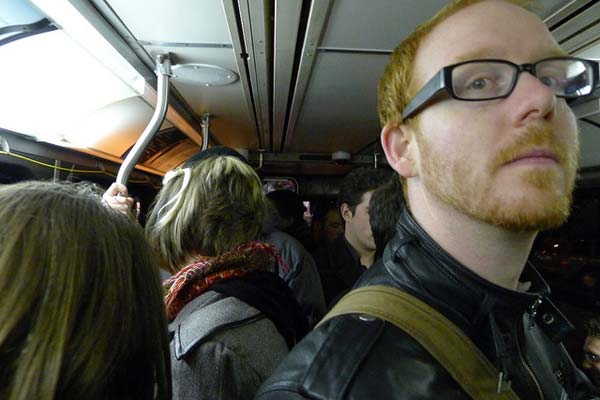
Alternative public transit on King West could spur change in TTC: alumni startup LineSix hits the streets
Published: January 9, 2015
The alumni who piloted an upstart transportation alternative in Toronto last fall are now set to launch regular morning and evening service – and experts say they may be changing the structure of public transit in the process.
“The Liberty Village Express will provide people living and working in Liberty Village with the best transit experience available,” said LineSix co-founder, Taylor Scollon. “And affordable prices make the Liberty Village Express a transit option everyone can use.” (Read more about LineSix)
Beginning January 19, the LineSix operating system will allow passengers of a private bus service along King Street West – the Liberty Village Express – to buy passes, track their bus and find stops via smartphone. Trips will cost as little as $4.25 with purchase of a month-long pass, down from the $5 rides offered during the week-long pilot in October.
“We have also added a stop at the Toronto Carpet Factory, introduced evening service, and added new trips.” Scollon told U of T News.
Morning and evening express buses will offer wi-fi along with an intention to provide other perks sometimes missing from the TTC experience:
“Passengers get a comfortable, reliable experience at an affordable price," said co-founder Brett Chang.
LineSix itself does not actually transport its users. Rather, the company partners with licensed, regular charter bus providers to operate their service.
“As the challenge of urban travel become an increasingly recognized fact of life, it's interesting to see that over the past number of years, entrepreneurs are turning their attention to transportation services,” said Matti Siemiatycki of U of T’s Department of Geography & Program in Planning. He groups LineSix with companies bringing innovations together with older forms of transportation in Toronto, such as Cars2Go and Uber.
“With respect to LineSix in particular, this is a creative approach to address the challenge of getting to and from work in a particularly busy travel corridor,” he said.
“The developers of LineSix are aiming to use mobile technologies to streamline ticket payment, vehicle tracking and customer feedback. These types of innovations have the potential to change the way people use mass transit and make it a more viable and desirable travel option that integrates with other modes of travel.”
The LineSix pilot last fall resulted in a mix of support and criticism. While some riders welcomed an alternative to over-long wait times for the King streetcar, reports suggested the LineSix model posed a legal challenge to the City of Toronto’s legal monopoly over transit services with the TTC.
“We don't own buses. We are a technology company,” Scollon told CBC in response. (Read about LineSix on CBC)
Semiatycki says the company is operating in “somewhat of a legal grey area,” but that its purpose is distinct from that of the TTC.
“They are targeted at a premium-paying clientele that book a seat in advance. A few hundred trips per day may be made on LineSix for the time being; tens of thousands are made by the TTC in that corridor.”
Issues of scale aside, LineSix riders will still have to travel through the gridlock worsened by the crawling pace of TTC streetcars. Semiatycki says that’s a greater problem that can only be solved through city planning.
“The main challenge in Liberty Village-Downtown travel corridor is congestion on the road where the streetcars run,” said Semiatycki. “The King and Queen streetcars are amongst the busiest lines in all of North America, each carrying over 50,000 passengers per day. And they travel in mixed traffic, with no dedicated lane. These high passenger volumes combined with heavy vehicle traffic make the service crowded and unreliable.
“Finding ways to give transit the priority on busy surface routes is essential to delivering a service that is quick, reliable and competitive with other travel options.”
Developing such an appealing mass transportation alternative scored the LineSix team a spot on the Globe and Mail’s year-end list of “Ten Torontonians who got things done in 2014.” (Read the Globe and Mail feature here)
“We are working on building the world's best operating system for transit, and we hope to get that into the hands of as many transit providers and transit users as possible,” said Scollon.
He spoke of his plans for an expanded version of LineSix in the Globe and Mail feature as well as in the U of T Cities podcast. (Learn more about LineSix in the U of T Cities podcast)
(Click the down-pointing arrow button in the player to download episode and transfer to your listening device. Transcript available here. Now available on iTunes.)
“I wouldn't say we are in the scaling phase yet. We are focused on providing our core customers with an excellent service, starting in the Liberty Village neighbourhood,” said Scollon.
But Semiatycki says even these early efforts could provoke change for public transportation at large.
“Especially when it comes to the integration of mobile technology, there may be ways that the TTC and others in the region can use the technological innovations from these upstarts to become more rider-friendly.”



